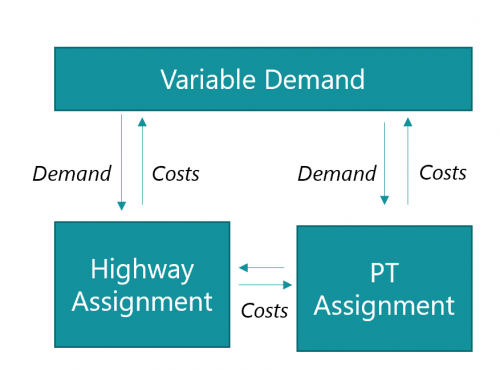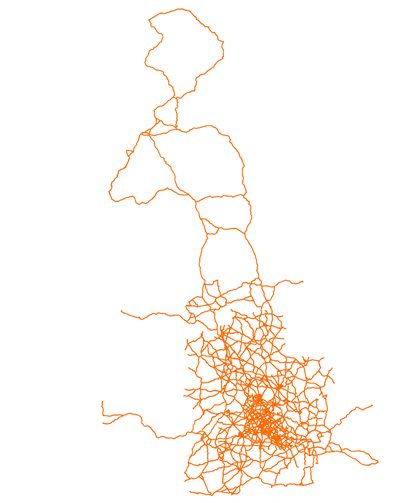Oxfordshire Mobility Model: MIMAS project update – November 2020
Model High level description/features
MIMAS will include the core components of a traditional strategic model (fig. 1):
- An aggregate demand and mode choice model;
- An agent-based highway assignment model;
- An aggregate public transport assignment model.

The Oxfordshire Mobility Model (OMM) includes a base year validated against 2019 data, and a do-minimum forecast year (2035). The model has a temporal coverage of 24 hrs, enabling users to evaluate daily variations on the transport network.
The demand model
The demand model forecasts the demand for travel, in the form of origin-destination trip matrices, aggregated by purpose (including education trips) and vehicle type. The decisions made by people about their activities (when, how and where) are modelled as a series of choices, dependent on each other, called a choice nest.
In a conventional four stage model, the starting point is a set of trip productions by zone and the choice nest is composed of dependent choices: mode, time period and destination choices. In MIMAS, additional choice models are considered, used to determine the service available (e.g. jobs or parking spaces).
The highway model
The highway network that underpins the OMM highway model covers the entire Great Britain (fig. 2) with a greatest level of detail (down to the tertiary road level) within the Oxfordshire area.

The network is enriched with data informing on the number of lanes, the allowed (or prohibited) vehicle types, and the speed limits.
The modes available in the model are highway, public transport and park & ride. The active modes are modelled as trip-ends, but do not form part of the assignment models. The vehicles types allowed on the highway network are car, LGV, HGV and bus.
The public transport model
A public transport assignment is the assignment of those people travelling by public transport.
The model is defined by:
- Public transport networks;
- Public transport routes;
- Cost of travelling, composed by fare, in vehicle time, walking time, waiting time and number of interchanges.
In MIMAS, combined mode assignments are considered, where the whole journey is made by multiple modes. An example is the park & ride use case, where part of the journey is made by car and part by bus.
The traffic simulator
The traffic simulator that underpins the highway model is a mesoscopic agent-based traffic simulator based on discrete event simulation.
The assignment method being developed at the moment for the first version of MIMAS is a periodic trip recalculation. Speeds and costs are taken from the current state of the network, and vehicles are routed accordingly. The first vehicle in the network will travel at free flow speed, and the delays experienced will be used to inform subsequent vehicle assignment.
The model outputs
The Key Performance Indicators (KPIs), that can be visualised at the end of a successfully completed simulation run are:
- Highway model outputs:
- Traffic flows;
- Turning flows;
- Average speed;
- Congestion metrics (queue lengths, density/jam-density, speed/free-flow-speed);
- Environmental indicators (CO2 and NOX) at link level;
- SLA (Select Link analysis);
- Public Transport model outputs:
- OD bus matrices;
- Passengers flows on highway links and railway links;
- Walk flows generated by agents catching the bus at bus stops.
- Demand model outputs:
- Agent-based demand with demographic attributes;
- Parking spaces utilisation.
Table of Contents
Latest news
Oxfordshire Mobility Model: MIMAS project update – April 2021
User Testing for MIMAS MIMAS is an innovative cloud-based transport modelling solution, built by a consortium of companies. Each partner within the consortium brings their own speciality and is responsible for a different aspect of the system. This
Oxfordshire Mobility Model: MIMAS project update – March 2021
Deploying MIMAS in the cloud MIMAS is a cloud-based transport modelling solution, developed for Oxfordshire County Council by a consortium of individual companies, each bringing specialized expertise, and each being responsible for separate components of the system. Previous
Oxfordshire Mobility Model: MIMAS project update – February 2021
A Local Authority Perspective MIMAS is Oxfordshire County Council’s next generation of transport model. It is a scalable transport modelling tool designed for the move towards a self-service paradigm. This month we asked Laura Peacock, Innovation Hub Manager